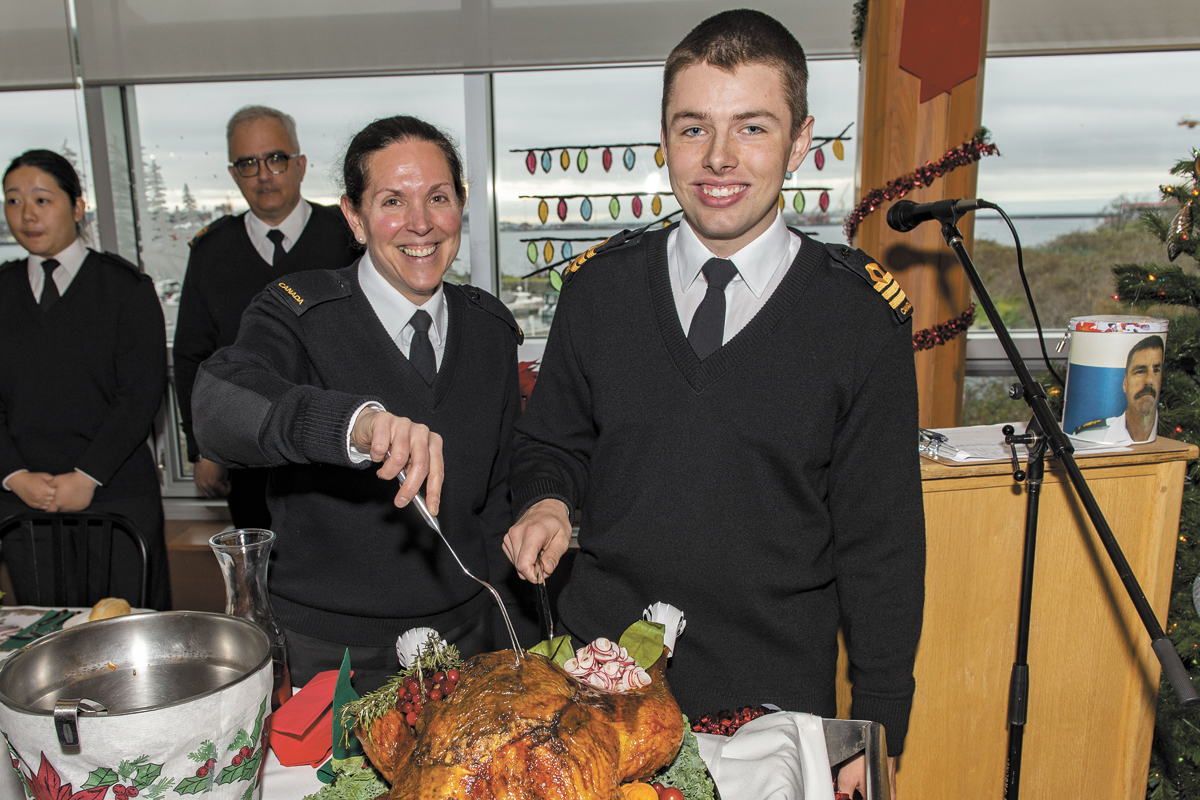Jackspeak: Holiday Traditions
By Lookout Production on Dec 21, 2022 with Comments 0

Ordinary Seaman William Bain, youngest sailor in the fleet, exchanges ranks with Commander Annick Fortin, Commanding Officer of Naval Fleet School (Pacific) in 2019.
—
The holiday season is a special time in an HMC ship or base. Seasonal decorations have been popular for decades and include traditions such as raising an evergreen up a ship’s yardarm or festooning the upper decks with pine boughs and coloured lights. In modern times, there is often a competition to see which ship has the best decorations.
The sailors’ Christmas celebrations became a relaxed routine, pranks and frivolity throughout the years. Today, a ship’s company’s holiday celebration includes a tradition where the youngest sailor changes places with the Commanding Officer for the day. They may even exchange tunics in a distant throwback to the ancient Roman custom of exchanging clothes and duties during Saturnalia. The honorary Commanding Officer for the day is often allowed to inspect the ship and issue orders, usually done in a lighthearted way. The celebration is capped by a lavish holiday feast consisting of turkey with all the trimmings, wine, plenty of side dishes, and a helping of duff, traditionally a Christmas pudding. For the sailors, the best part of the dinner is that it is served by the officers, done so as a thank you for the hard work and accomplishments of the previous twelve months.
The holiday season can be a quiet moment for HMC ships as there tends to be a scheduled leave period. However, for the ships in the HMC dockyard, there is a tradition that occurs at midnight on New Year’s Eve when the youngest member, sailor or officer is tasked to ring the bell eight times for the outgoing year and eight times for the New Year. Bells ringing up and down the dockyard often accompany ships’ horns sounding off in celebration.
In the morning on New Year’s Day, a tradition practiced in Canada is for the Governor-General, Lieutenant-Governors, municipal authorities, Legions and military establishments to host a Levee. The concept of a Levee is derived from the French King Louis XIV, who would receive his subjects upon rising in the morning. Levee is derived from the Latin word ‘levāre’- to rise. Canadians began associating a Levee with the holiday season when fur traders came to pay their respects to the master of the fort on New Year’s Day.
New Year’s Levee is a time for visiting and toasting the new year at other military units, the offices of local officials, and Legions. Amongst good food, beverages are shared, with nothing being more traditional than a cup of ‘Moose Milk’. The recipe of this creamy punch changes depending on the military formation, but spirits are almost always included. In Navy units, the basic ingredients are rum mixed with vanilla ice cream. Specific recipes may be closely guarded secrets, including Kahlua, Bailey’s Irish Cream, and nutmeg or cinnamon for taste. Moose Milk can be a delightful concoction if consumed safely. Have a safe and happy New Year!
You will find over 4,000 examples of Jackspeak in my book Jackspeak of the Royal Canadian Navy (2nd ed.).
The author of ‘Jackspeak of the Royal Canadian Navy’ and ‘Whiskey 601’, Mark Nelson developed a love of the Navy’s language and lifestyle over his 26-year career in the service. After retiring as a Chief Petty Officer Second Class, he now works as a Library Systems Specialist at Red River College Polytechnic in Winnipeg, Man.
Follow Mark on Twitter @4marknelson
Filed Under: Top Stories
About the Author:





